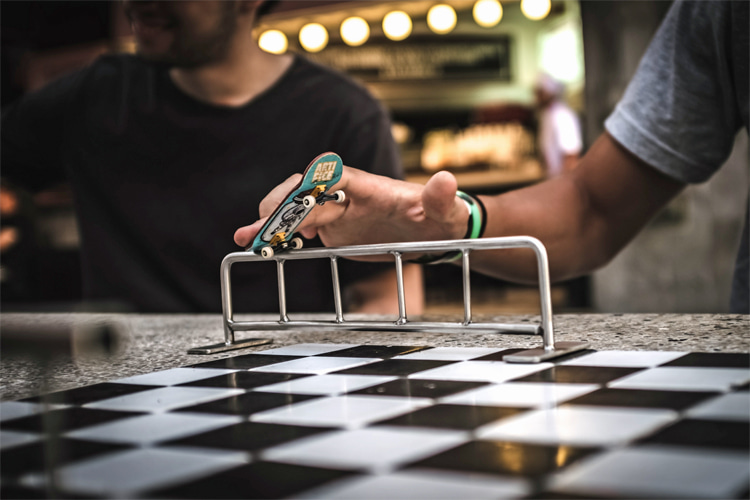A fingerboard is a small-scale working replica of a real skateboard.
The tiny sidewalk surfboard allows riders to recreate and reproduce skateboarding's core tricks and maneuvers by using their middle and index fingers.
A fingerboard features everything a standard-size skateboard has. There's the grip tape, the wooden, plastic, or paper deck, bushings, and interchangeable wheels and trucks.
In most cases, fingerboards are 3.9 inches (100 millimeters) long and between 1-to-1.3 inches (26-to-34 millimeters) wide.
The scale ratio between a real skateboard and a fingerboard is approximately 1:8.
Several books have been published about the art of fingerboarding.
If you want to learn the basics, the fundamental tricks, and riding techniques, the following publications will help you start.
Get "The Beginners Guide to Fingerboarding," "Fingerboard Tricks Made Easy," "Unofficial Tech Deck Skateboard Tricks: The Complete Handbook," and "Build Your Own Fingerboard Skatepark."
And yes, you can do an ollie just like on a standard skateboard.
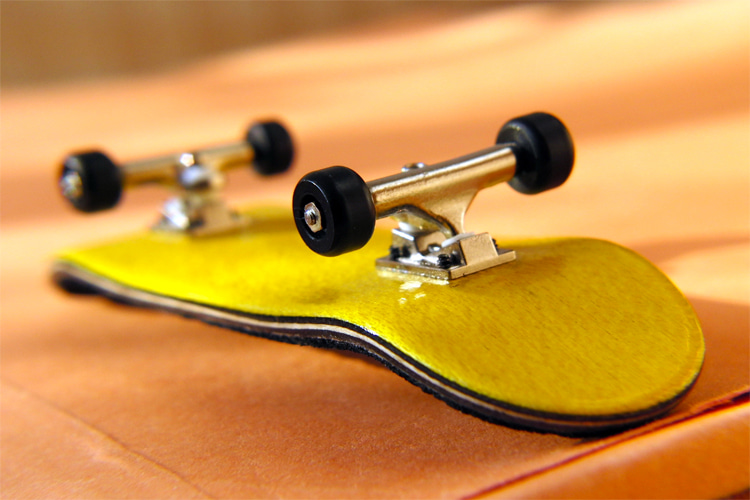
The History of the Fingerboard
According to historians, the scaled-down version of the modern skateboard was invented and first played by Lance Mountain.
The Bones Brigade skateboarder presented the fingerboard to the world in Powell Peralta's 1985 video "Future Primitive."
In the video's chapter four, Mountain trains his contest runs while skating a fingerboard in a metal double-bin sink surrounded by impressed friends.
The first skate toy was made from cardboard, coffee stirrers, and Hot Wheels axles.
Despite the immediate impact of the toy's entertaining potential, the commercialization of the first mass-produced models only really began a decade later.
In the late 1990s, Spin Master, a Canadian toy company, launched Tech Deck, a label that would explore skate brand logos' marketing potential in small skateboards.
Tech Deck quickly became a synonym for fingerboards and fingerboarding.
In the late 1990s, one brand sold over 20 million finger skateboards.
With the turn of the millennium, new labels stepped in - Super Mini Boards, Deluxe Finger Banger Boards, Buckledown, Berzerk, and Pro Precision are only a few examples.
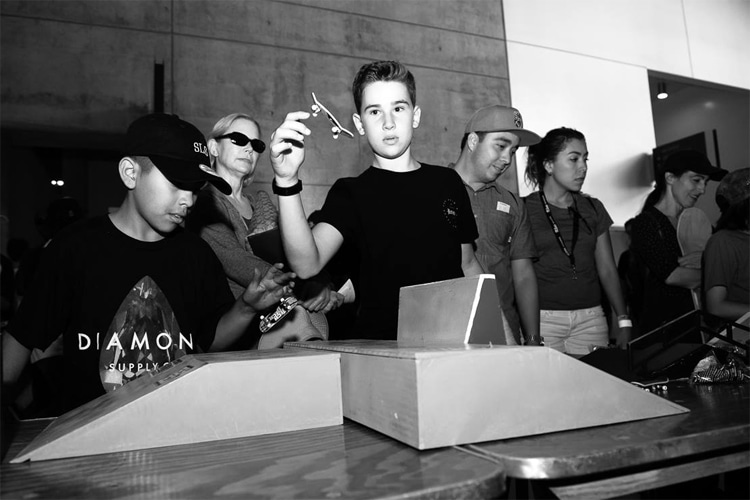
The fingerboard fever quickly crossed the skateboard market's border.
Soon, tiny sidewalk surfboards were being sold in Wal-Mart, Toys 'R Us, and other major retail stores.
Nevertheless, it is fair to say that Lance Mountain's use of miniature skateboards was inspired by 1960s homemade fingerboards before being widely sold as keychains in skate and gift shops.
The truth is that fingerboards brought many Generation X and Millennial kids into skateboarding and fueled the skater's passion for the sport.
The early fingerboard market players had brand license logos from the sport's most famous companies, including Alien Workshop, A-Team, ATM, Birdhouse, Black Label, Blind, Chapman, Element, G&S, Gullwing, Grind King, Flip, Hook-Ups, Maple, New Deal, New School, Santa Cruz, World Industries, Zero, and Zoo York.
These brands received not only royalties for every fingerboard sold but also free advertising. All of a sudden, fingerboard contests were attracting hundreds of competitors and spectators.
So, it is no surprise that disputes and lawsuits over the use of the word "fingerboard" as a generic term or trademark started to appear.
At one point, there were even fingerboard toys inside McDonald's Happy Meal. However, with time, the mental skating madness faded away.
Fingerboards became collectible toys and inexpensive items that could easily be bought anywhere and were even given away as freebies by skate shoe and clothing companies.
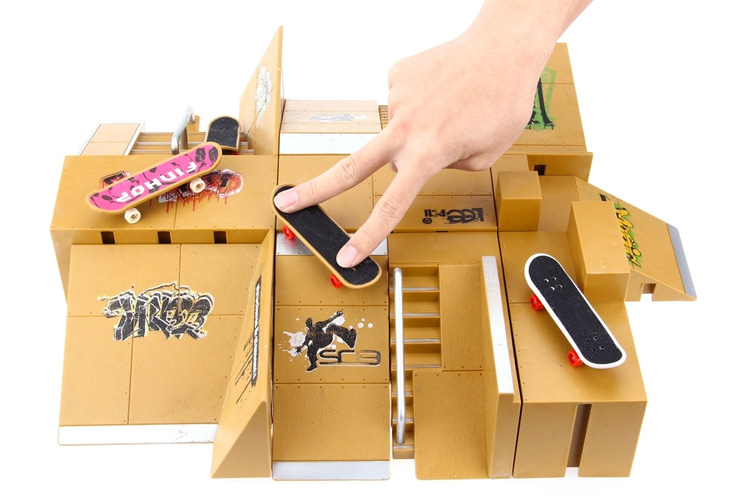
Fingerboarding Is Not Dead
The fingerboard scene is still active and vibrant in Europe, Asia, and America. There are workshops, fairs, and contests being run regularly.
In 2000, Martin Ehrenberger created the Fast Fingers contest series.
The event grew, and in 2008, the fingerboard pioneer debuted the Fingerboard World Championship, making it the world's most prestigious miniature skateboarding competition.
Fingerboards are affordable toys, but their price has remained relatively stable since the mid-2000s.
The fingerboard industry was quick to capitalize on the success of these small, four-wheel toys, adding new gear, components, and extras to the cart.
Today, you'll find hundreds of accessories and objects that will help you build the ultimate modular fingerboard skatepark and simulate your favorite street skating spot.
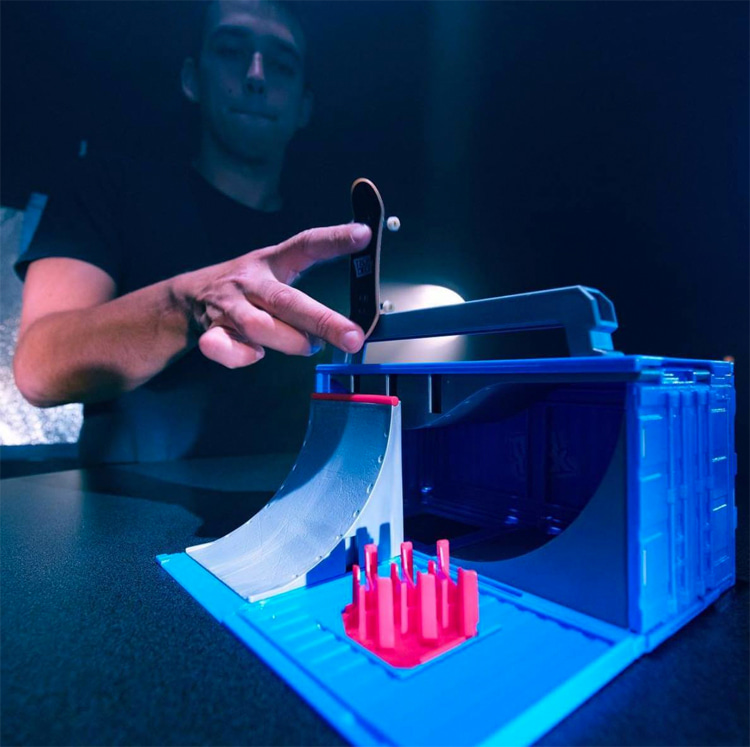
Do a quick online search, and you'll find starter kits, fully assembled boards, collector's editions, halfpipes, ramp sets, handrails, benches, stairs, funboxes, spines, tuning tools, fingerboard completes, replacement parts, and other useful components.
There's everything you need to recreate the outdoor skateboarding experience in the corner of your living room.
Several fingerboard brands are still manufacturing quality skating miniatures.
Yellowood, Tech Deck, Teak Tuning, Lowpro, Berlinwood, Pro Fingerboards, Planktoon, and Skull are companies producing fingerboards, hardware, playgrounds, and portable parks.
Fingerboarding is an excellent training tool for skateboarders, as it can be used as a 3D model to simulate and help understand how to land real-life tricks and maneuvers.
So, despite being a tight-knit recreational activity, there's definitely an active professional fingerboarding community out there.
